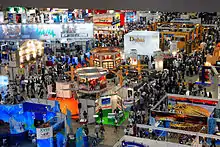Fair (event)
A fair is a gathering of people for a variety of entertainment or business related activities. A fair may last for several days or weeks and may occur every year at a specific location.


Types

Some fairs from generally smallest or biggest include:
- Village fair, a festival, party or celebration that happens every year or every few years. Traditionally, they were held to celebrate a good harvests or religious gatherings.
- Traveling funfair/carnival, an amusement show made up of amusement rides, food stalls, merchandise selling stalls, games of "chance and skill", thrill acts and (now less often) animal acts.
- A town/city's street fair or market celebrates character of a neighborhood and local merchants.
- County fair (USA) or county show (UK), a public event displaying the equipment, animals, sports and recreation associated with agriculture and animal breeding.
- Regional or state fair, an annual competition and recreation get-together. Including exhibits or competitors that have won a prize at the local fairs.
- Trade fair, an event held so that companies in a specific industry can showcase and demonstrate their latest products and services, study activities of rivals, and examine recent market trends and opportunities.
- Festival, an event ordinarily coordinated with a theme e.g. music, art, season, tradition, history, ethnicity, religion, or a national holiday.
History



The Roman fairs were holidays on which there was an intermission of labor and pleadings. In the Roman provinces of Judea and Syria Palaestina, Jewish rabbis prohibited Jews from participating in fairs in certain towns because the religious nature of the fairs contravened the prescribed practice of Judaism.[1]
In the Middle Ages, many fairs developed as short-lasting markets and were very important for long-distance and international trade. Traders travelled, sometimes for many days, to fairs where they could be sure to meet those they needed to buy from or sell to. Fairs were usually tied to special Christian religious events, such as the Saint's day of the local church. Stagshaw, in England, held annual fairs as early as 1293 consisting of the sales of animals. Along with the main fair held on 4 July, the city also hosted smaller fairs throughout the year where certain types of animals were sold, such as one for horses, one for lambs, and one for ewes.[2]
The Kumbh Mela, held every twelve years, at Allahabad, Haridwar, Nashik, and Ujjain is one of the largest fairs in India, where more than 60 million people gathered in January 2001, making it the largest gathering anywhere in the world.[3][4][5] Kumbha means a pitcher and Mela means fair in Sanskrit.
In the United States, fairs draw in as many as 150 million people each summer.[6] Children's competitions at an American fair range from breeding small animals to robotics, whilst the organization 4-H has become a traditional association.[6]
References
- Schäfer, Peter (2002). The Talmud Yerushalmi and Graeco-Roman Culture. Mohr Siebeck. pp. 448–. ISBN 9783161478529. Retrieved 8 June 2015.
- Norderhaug, Jennifer; Thompson, Jennifer Norderhaug & Barbara (2006-08-01). Walking the Northumbria Dales: Un. Sigma Press. pp. 63–. ISBN 9781850588382. Retrieved 8 June 2015.
- Millions bathe at Hindu festival BBC News, January 3, 2007.
- Kumbh Mela pictured from space - probably the largest human gathering in history BBC News, January 26, 2001.
- Lewis, Karoki (2008-03-22). "Kumbh Mela: the largest pilgrimage". The Times. Archived from the original on 2010-05-29. Retrieved 2019-09-18.
- Von Drehle, David (2007-07-23). "A new Day at the Fair". Time. Vol. 170, no. 4. Photographs by Greg Miller. p. 50. ISSN 0040-781X.
Further reading
- . Encyclopædia Britannica. Vol. 10 (11th ed.). 1911.